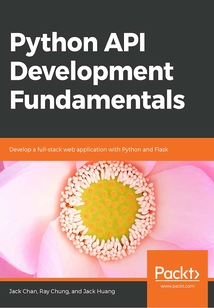舉報 

會員
Python API Development Fundamentals
最新章節:
10: Deployment
Pythonisaflexiblelanguagethatcanbeusedformuchmorethanjustscriptdevelopment.ByknowingthePythonRESTfulAPIswork,youcanbuildapowerfulbackendforwebapplicationsandmobileapplicationsusingPython.You'lltakeyourfirststepsbybuildingasimpleAPIandlearninghowthefrontendwebinterfacecancommunicatewiththebackend.You'llalsolearnhowtoserializeanddeserializeobjectsusingthemarshmallowlibrary.Then,you'lllearnhowtoauthenticateandauthorizeusersusingFlask-JWT.You'llalsolearnhowtoenhanceyourAPIsbyaddingusefulfeatures,suchasemail,imageupload,searching,andpagination.You'llwrapupthewholebookbydeployingyourAPIstothecloud.Bytheendofthisbook,you'llhavetheconfidenceandskilltoleveragethepowerofRESTfulAPIsandPythontobuildefficientwebapplications.
目錄(113章)
倒序
- 封面
- 版權頁
- Preface
- About
- About the Book
- 1. Your First Step
- Learning Objectives
- Introduction
- Understanding API
- RESTful API
- HTTP Protocol
- HTTP Methods and CRUD
- The JSON Format
- HTTP Status Codes
- Open API
- The Flask Web Framework
- Building a Simple Recipe Management Application
- Using curl or httpie to Test All the Endpoints
- Postman
- Summary
- 2. Starting to Build Our Project
- Learning Objectives
- Introduction
- What is Flask-RESTful?
- Virtual Environment
- Creating a Recipe Model
- Configuring Endpoints
- Making HTTP Requests to the Flask API using curl and httpie
- Summary
- 3. Manipulating a Database with SQLAlchemy
- Learning Objectives
- Introduction
- Databases
- SQL
- ORM
- Defining Our Models
- Password Hashing
- Summary
- 4. Authentication Services and Security with JWT
- Learning Objectives
- Introduction
- JWT
- Flask-JWT-Extended
- Designing the Methods in the Recipe Model
- Refresh Tokens
- The User Logout Mechanism
- Summary
- 5. Object Serialization with marshmallow
- Learning Objectives
- Introduction
- Serialization versus Deserialization
- marshmallow
- A Simple Schema
- UserSchema Design
- RecipeSchema Design
- The PATCH Method
- Summary
- 6. Email Confirmation
- Learning Objectives
- Introduction
- Mailgun
- User Account Activation Workflow
- HTML Format Email
- Summary
- 7. Working with Images
- Learning Objectives
- Introduction
- Building the User Avatar Function
- Flask-Uploads
- Image Resizing and Compression
- Introduction to Pillow
- Summary
- 8. Pagination Searching and Ordering
- Learning Objectives
- Introduction
- Pagination
- Paginated APIs
- Recipe Searching
- Sorting and Ordering
- Summary
- 9. Building More Features
- Learning Objectives
- Introduction
- Caching
- Flask-Caching
- API Rate Limiting
- Flask-Limiter
- Summary
- 10. Deployment
- Learning Objectives
- Introduction
- Deployment
- Comparing SaaS PaaS and IaaS
- The Heroku Platform
- Configuration Handling in Smilecook
- Heroku Application
- Heroku Add-Ons
- Setting Up Environment Variables for the Heroku App
- Setting Up Variables in Postman
- Setting up the Front-end Interface to Work with the Smilecook API
- Summary
- Appendix
- About
- 1: Your First Step
- 2: Starting to Build Our Project
- 3: Manipulating a Database with SQLAlchemy
- 4: Authenticated Services and Security with JWTs
- 5: Validating APIs Using marshmallow
- 6: Email Confirmations
- 7: Working with Images
- 8: Pagination Searching and Ordering
- 9: Building More Features
- 10: Deployment 更新時間:2021-06-11 12:56:47
推薦閱讀
- SEO 20日
- 社交電商運營策略、技巧與實操
- 物聯網安全與深度學習技術
- 走進物聯網
- 物聯網時代
- Yii Application Development Cookbook(Second Edition)
- Master Apache JMeter:From Load Testing to DevOps
- 5G技術與標準
- Learning Windows 8 Game Development
- 深入理解OpenStack Neutron
- 網絡空間全球治理觀察
- 全聯網標識服務
- 商業的本質和互聯網
- 區塊鏈社區運營手冊
- 視聽變革:廣電的新媒體戰略
- 物聯網概論
- OpenShift Cookbook
- 網絡是怎樣連接的
- 移動GIS應用開發實踐:Android平臺下的GIS功能開發實戰
- 深入理解物聯網
- 計算機網絡應用基礎(第3版)
- VMware vSphere企業運維實戰
- 計算機網絡基礎(第4版)
- 華為HCIA路由與交換技術實戰
- 順”信”而為:信息化思維與領導力
- Hands-On Full:Stack Development with Swift
- Full-Stack React Projects
- LiveCode Mobile Development Cookbook
- 實施Cisco統一通信管理器(CIPT2)
- 網絡信息內容審計

